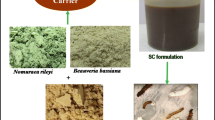Abstract
The field persistence and efficacy of Bacillus thuringiensis formulations
The persistence of spores ofBacillus thuringiensis (commercial formulation Dipel and Bathurin) on oak leaves under different climatic condition in field trials was determined. The killing activity of these preparations against wintermothOperophthera brumata and green oak tortrix Tortrix viridana was parallely tested. Within the first week after the application of bacterial preparations the viable spore count on leaves was reduced of two up to three orders. The efficacy of bacterial preparations depends, however, on the environmental temperature occurring within the first week after the application. The adequate temperature is the primary deciding for the feeding activity of caterpillars and for the virulence of the preparations. For aerial application doses of 0.5 to 1.0 kg of the preparation in 50 100 l of water per one ha were sufficient. In the contrary, Dipel WP in oil suspension was unsufficient for aerial application because of mechanical blocking of the nozzles. The optimal time for the procedure was the first week of May in our climatic conditions.
Similar content being viewed by others
Literaturverzeichnis
Baranova, V. P., 1972: (Zirkulation vonBacillus thuringiensis Berliner undSerratia marcescens Bizio im Milieu der Insekten des Krim.) Kandidatendiss., Vaschnil Leningrad (in russisch).
Bonnefoi, A., undBéguin, S., 1959: Recherches sur l'action des cristaux deBacillus thuringiensis Berliner souche Anduze. Entomophaga 4, 193–199.
Burges, H. D., Hillyer, S., Chanter, D. O., 1975: Effect of Ultraviolet and Gamma Rays on the Activity of (δ-Endotoxin Protein Crystals ofBacillus thuringiensis. J. Invertebr. Pathology 25, 5–9.
Cantwell, G. E., 1967: Inactivation of biological insecticides by irradiation. J. Invertebr. Pathol. 9, 138–140.
Chládek, Z., 1966: (Zu einigen Fragen der Applikation von Pestiziden.) Agrochemia 4, 103–109) (in tschechisch).
Frye, R. D.;Scholl, C. G., Scholz, E. W., Funke, B. R., 1973: Effect of weather on a microbial insecticide. J. Invertebr. Pathol. 22, 50–54.
Krieg, A., 1974: Die Wirkung ultravioletter Strahlen auf Sporen vonBacillus thuringiensis und Versuche zum Strahlenschutz. Z. Pflkrankh. Pflschtz. 81, 591–596.
Krieg, A., 1975: Photoprotection against inactivation ofBacillus thuringiensis spores by ultraviolet rays. J. Invertebr. Pathol. 25, 267–268.
Pinnock, D. E., Brand, R. J., Milstead, J. E., 1971: The field persistence ofBacillus thuringiensis spores. J. Invertebr. Phatol. 18, 405–411.
Pinnock, D. E., Brand, R. J., Jackson, K. L., Milstead, J. E., 1974: The field persistence ofBacillus thuringiensis spores onCercis occidentalis leaves. J. Invertebr. Pathol. 23, 341–346.
Švestka, M., 1973: (Zahlen- und umfangsmäßige Zusammensetzung des Spektrums der Spritzmittel bei der flugtechnisch durchgeführten Applikation von Insektiziden in Ö llösungen in kleinen Volumina für Fichtenbestände.) Práce VÚLHM, 44: 81–93 (in tschaechisch).
Author information
Authors and Affiliations
Rights and permissions
About this article
Cite this article
Vaňková, J., Švestka, M. Persistenz und Wirksamkeit von Bacillus thuringiensis — Präparaten in Freilandversuchen. Anz. Schadlingskde., Pflanzenschutz, Umweltschutz 49, 33–38 (1976). https://doi.org/10.1007/BF02342164
Issue Date:
DOI: https://doi.org/10.1007/BF02342164




